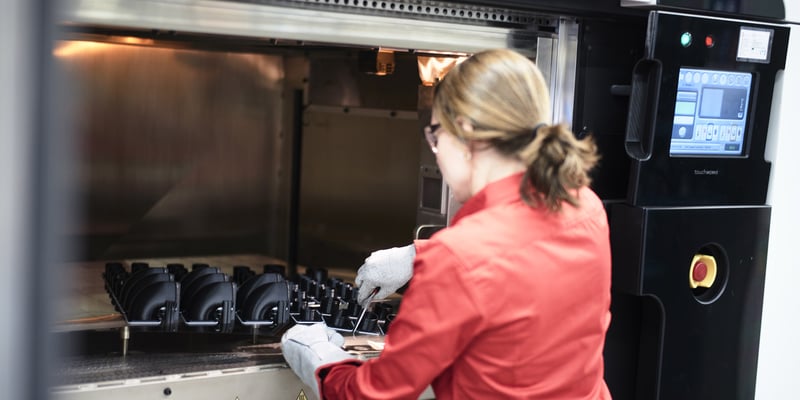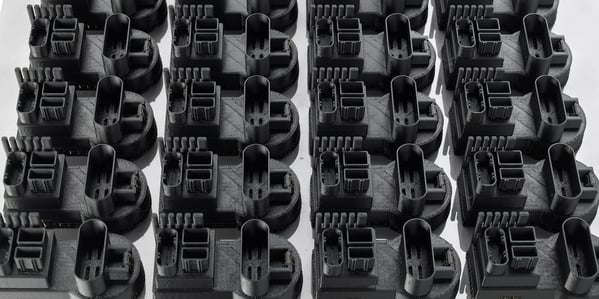Low-volume Production: 7 Benefits of 3D Printing
-
By
Marie-Christine Flibotte
February 23 2024
-
Tech tips and tutorials

3D printing, also called "additive manufacturing", presents many advantages for low-volume production compared to traditional manufacturing processes. This approach stands out for the speed of producing high-quality parts, production flexibility, cost reduction and risk reduction.
Although additive manufacturing has general advantages that are now well known, it can be particularly attractive for low-volume manufacturing. Discover seven reasons to use 3D printing for low-volume production and compare the advantages of this technology to traditional processes according to your needs and quantities.
1. Agility
2. Reduce Inventory with On-demand Production
3. Wide Variety of SKU (Stock Keeping Units)
4. Part Consolidation
5. Print Production with a Reliable Partner
6. Mass Customization
7. Efficient Business Models Based on Low-volume Production
Why Use 3D Printing for Low- and Large-series Production?
1. Agility
Eliminating custom tooling and reducing labour time speeds up manufacturing processes and provides great flexibility in terms of part modification or new designs. It goes without saying that this manufacturing agility has beneficial effects on companies' commercial and financial growth.
2. Reduce Inventory with On-demand Production
3D printing in low-volume series is often used to produce parts on demand. This approach makes it easier to manage orders: It limits the risk on account of unsold products and makes it possible to actively respond to an unexpected increase in demand or sporadic high demand. With a rapid and on-demand production, additive manufacturing avoids stock storage and the various associated costs.
3. Wide variety of SKU (Stock Keeping Units)
Considering that 3D printing does not require specialized tooling for each product, a mix of SKU and different parts can be considered in the same production batch on the same equipment. Thanks to this flexibility, it is possible to combine several products or SKUs, and thus increase the production rate.
4. Part Consolidation
In the context of low-volume production, 3D printing allows you to print a complex part or assembly in its entirety, in a single step. In other words, the post-production assembly process is eliminated when consolidating multiple sub-assemblies. Such an approach saves time, reduces costs, and simplifies the supply chain by having fewer suppliers involved. In a context of short series, this is all the more beneficial.
5. Print Production with a Reliable Partner
Companies are integrating more and more small 3D printers internally to cover basic needs. However, when it comes to low-volume series production by 3D printing, you can quickly be bounded by a limited number of small printers. Doing business with a reliable partner specialized in additive manufacturing is therefore necessary, and offers a significant advantage, particularly in terms of productivity, communication, and expertise.
Indeed, factories specializing in additive manufacturing obtain better yields, better consistency in production and better dimensional tolerancing of parts. In addition, it produces high quality parts, delivered faster than traditional manufacturing, and product variations between different batches are reduced.
For example, Solaxis has production-grade quality equipment and fully automated processes, which allow it to be efficient for low-volume series projects. This offers:
- A large production capacity
- Production Flexibility
- Optimum performance
- Repeatable quality parts
- Consistency between the different product batches
- Speed of execution and production

6. Mass Customization
Another advantage of 3D printing for low-volume series production is product customization. This technology is in fact preferred over traditional processes as it makes it possible to easily design and produce parts with complex geometry combining precision, resistance, durability, and aesthetics. This is an approach of choice to manufacture different products, or different prototypes and test them in the same production batch, and then produce the final part in low volumes and sometimes even at higher volume.
Once the design and prototype have been approved, it is possible to use the same 3D printing technology and material for the final manufacturing. This therefore avoids transferring production to another manufacturing process.
7. Efficient Business Model Based on Low-volume Production
Depending on business needs and demand, additive manufacturing lends itself well to on-demand and low-volume series manufacturing (made to order, just in time, and same day). By integrating this new approach into business strategies, it makes it possible to evolve business models for better financial profitability.
Why Use 3D Printing for Low- and Large-Series Production?
The advantages of 3D printing for low-volume and larger production - in some cases, are numerous. Indeed, this technology stands out from traditional manufacturing processes for various reasons. Let's take a closer look.
|
|
Traditional Processes / High Volume
|
Traditional Processes / Low Volume
|
Additive Manufacturing |
|
Capacity |
Ideal for mass production. |
Ideal for low- and medium-series production. |
Single part printing, or printing low or medium productions. Depends on printer specificities and product physical characteristics. |
|
Tooling / Mold |
Required. Complex and very expensive tooling. |
Required. Medium to high complexity tooling. |
Not required |
|
Minimum quantity required |
High |
Moderate |
≥1 |
|
Variety of parts (SKU mix) |
Requires fairly similar geometry parts to limit adaptations. |
Requires fairly similar geometry parts to limit adaptations. |
No issue. Printing a single SKU or a mix of several SKUs. |
|
Assembly |
Requires adapting the design to minimize assembly steps. |
Requires adapting the design to minimize assembly steps. |
Little or no assembly. |
|
Cost Structure |
High CAPEX, amortized with production. |
Moderately high CAPEX, amortized with smaller production. |
No tooling. No initial investment. |
Thanks to its agility, 3D printing greatly simplifies part manufacturing, whether it is a question of designing a prototype or carrying out low- or high-volume production - in some cases. Its easy implementation and the advantages of this technology in terms of flexibility of design open the door to innovation. Therefore, the integration or adoption of 3D printing in your business allows you to remain efficient and competitive.
Questions about low-volume 3D printing? Contact us! Our team of professionals will be happy to answer and advise you.


